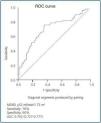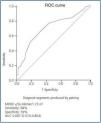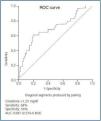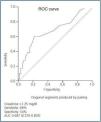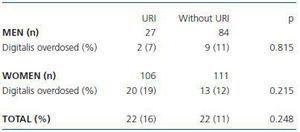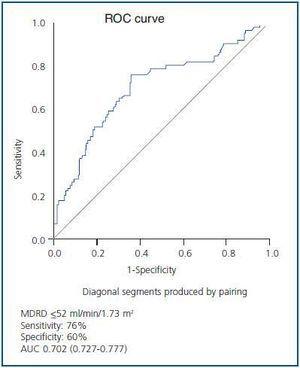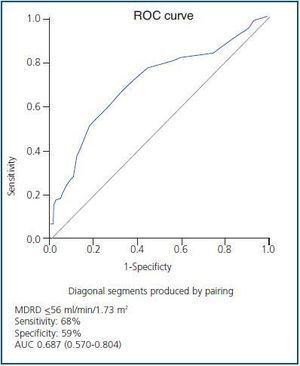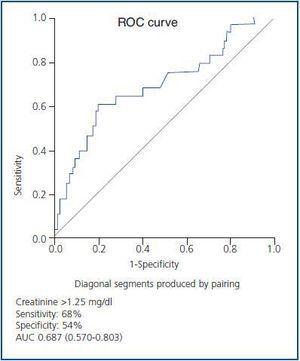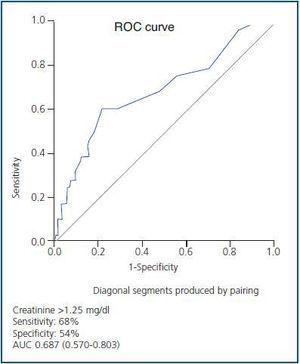Introducción: la Enfermedad Renal Crónica plantea importantes problemas de sobredosificación digitálica y hace necesario el ajuste de dosis y la valoración de la función renal, que se realiza habitualmente mediante la creatinina sérica. Nuestro objetivo fue valorar las ventajas de la creatinina sérica y de la ecuación MDRD para detectar insuficiencia renal oculta y poder reducir el riesgo de sobredosificación digitálica. Material y métodos: estudio descriptivo transversal durante un año, en el que se analizaron las determinaciones de digoxina desde la base de datos del laboratorio. Se excluyeron pacientes infradosificados y menores de 18 años. Se emplearon las pruebas chi cuadrado (p <0,05), curvas ROC, así como análisis de regresión logística, mediante el programa SPSS. Resultados: se realizaron 1.228 determinaciones de digoxina a 679 pacientes (273 varones 77 ± 10 años, y 406 mujeres 82 ± 8 años), de los que el14% estaba sobredosificado (28 varones y 67 mujeres). Se observan diferencias significativas en sobredosificación en los que tienen creatininas elevadas respecto a creatinina normal (31 vs. 10% en varones, 44 vs. 15% en mujeres). Mediante curvas ROC, la mayor eficacia diagnóstica se obtendría en varones, con cifras de MDRD <56 ml/min/1,73 m2, y mujeres MDRD <52 ml/min/1,73 m2. El 68% de varones sobredosificados tenían descensos de MDRD, frente al 61% con creatininas elevadas; el 81% de las mujeres sobredosificadas tenían descendido MDRD frente al 51% con elevación de creatinina. Conclusiones: cifras de creatinina normales esconden insuficiencias renales que aumentan el riesgo de sobredosificación. Utilizar el descenso de la tasa de filtrado glomerular estimado mediante la ecuación MDRD es mejor que utilizar las cifras de creatinina elevadas para detectar sobredosificación digitálica, por lo que constituye una herramienta muy útil para poder reducir el riesgo de sobredosificación, sobre todo en mujeres.
Introduction: Digoxin overdose is closely related to Chronic Kidney Disease and creatinine dosage adjustment is usually needed. Our goal was to assess the advantages of serum creatinine and the MDRD equation to detect hidden renal insufficiency to reduce the overdose Digital risk. Methods: We describe all digoxin samples processed and registered in our hospital laboratory database for a year. Patients under 18 years and samples bellow therapeutic ranges were excluded. Chi square (p<0.05), ROC curves and logistic regression analysis were conducted. SPSS software was used. Results: Between 1228 digoxin samples taken to 679 patients (273 men, 77 ± 10 years old , and 406 women 82 ± 8 years old), 14% were over therapeutic range (28 men and 67 women). Significant differences were observed in over dosage between high creatinine group regarding to normal creatinine group (31% vs. 10% in men, 44% vs. 15% in women). ROC curves showed that the most accurate levels to predict digoxin over dosage were MDRD <56 ml/min/1.73m2 in men and MDRD <52 ml/min/1.73m2 in women. 68% of over dosage men had declines of MDRD levels, compared to 61% with high creatinine levels, 81% of over dosage women had declines of MDRD compared to 51% with elevated creatinine levels. Conclusions: Even in patients with normal creatinine levels, chronic kidney disease enhances digoxin over dose risk. Using the decline of glomerular filtration rate estimated by the MDRD equation is better than elevated creatinine levels to detect digoxin overdose, thus constituting a very useful tool to reduce the risk of overdose, especially among women.
INTRODUCTION
The burden of cardiovascular disease on advanced societies is becoming more pronounced as life expectancy in creases and is associated with a high prevalence of CKD in elderly patients with Chronic Heart Failure (CHF).1
Digoxin is a medicine used in CHF treatment to control symptoms when they do not respond to conventional treatment,2 and is used to control cardiac rate in cases of atrial fibrillation with an uncontrolled ventricular response, producing a decrease in hospitalizations due to acute heart failure without effect on global mortality.3 Its use can be problematic, particularly with dosing which requires monitoring blood levels to avoid unwanted side effects which are the result of reduced excretion which is predominantly renal. In addition to this, its pharmacological effect varies according to fluid and electrolytes abnormalities, common in advanced stages of CKD and which necessitates calculation of dosage based on renal function.
Glomerular Filtration Rate (GFR) is the best measurement for renal function, although in daily practice the most commonly used parameter is serum creatinine (Cr) and more recently, estimated Glomerular Filtration Rate (eGFR) using an equation derived from the MDRD study,4 which avoids possible collection errors in 24 hour urine samples and allows cases of Unrecognized Renal Insufficiency (URI) to become evident in individuals with apparently normal Cr.
The objective of our study was to determine the utility of Cr levels and values of eGFR using the MDRD equation, to reveal URI and be able to reduce the risk of digitalis overdosage.
MATERIAL AND METHODS
One year long cross-sectional study (January 2006 to January 2007) in which digoxin determinations were analysed using the laboratory database of a regional hospital with 500 beds serving a population of approximately 300,000. For patients with several measurements of digoxin levels, only the first was taken into consideration, as we assumed that drug dosage adjustments were made. We only included patients over 18 years of age to be able to utilize the equation MDRD-4 to determine the eGFR (MRDR [ml/min/1.73m2] = 186x [creatinine/88.4]-1.154 x age-0,203 x 0.742 if it is a woman). Underdosed patients were excluded from the study after confirmation that many of them had undetectable levels of the medicine in the blood probably due to lack of compliance with the medication. Only levels within and above therapeutic range were included.
We considered that there is URI when Cr levels are normal (< 1.3mg/dl in women and < 1.4mg/dl in men) and eGFR values are low (< 60ml/min/1.73m2). Cr measurement was done by a kinetic method (Dade Behring-Dimension RXL autoanalyzer).
Results were expressed as average and standard deviation and proportions. For comparisons, the Chi-square test was used, considering p < 0.05 as statistically significant. ROC curves were used to find the cut-off point of MDRD and Cr with better sensitivity/specificity for detection of overdosage. To find the parameter which best defined digoxin levels, a one-step logistic regression analysis was used, which included the most used variables for the calculation of renal function (age, sex, Cr and MDRD). The entire statistical analysis was performed by the SPSS (version 12.0) package.
RESULTS
During 2006, 1,228 digoxin determinations were carried out, corresponding to 679 patients (273 men, age 77 ± 10 years, Cr 1.54 ± 1.36 and 406 women, age 82 ± 8 years, Cr 1.19 ± 0.57). Out of all determinations, 314 (46%) were outside the therapeutic range (0.8-2ng/ml); 32% underdosed, compared with 14% overdosed. Out of those overdosed, 28 were men and 67 women. There were 166 men and 294 women who were either dosed correctly or overdosed.
The percentage of patients with chronic renal failure (CRF) was greater in the group of those overdosed than in the group of those not overdosed, both in men (73 vs. 40%, p = 0.0003) and in women (81 vs. 52%, p < 0.0001).
In the men’s group, 111 had a normal Cr and 11% of those without URI were found to be overdosed compared with 7% of those overdosed in the group of patients with URI, with no significant differences among them. Similarly, of the 217 women with normal Cr, they showed digoxinaemia levels above the highest normal range, 12% of those without URI compared with 19% in the group that showed URI, but without significant differences (table 1).
Using Cr as a marker for renal function, 10% of the men with normal Cr (MDRD 80 ± 35ml/min/1.73m2) were found to be overdosed compared with 31% of those which showed elevated Cr (MDRD 30 ± 14ml/min/1.73m2) and the differences were significant (p = 0.0015). An elevated Cr in males increased the risk of overdosage by 3.1 (table 2).
Among the women with normal Cr (MDRD 65 ± 22ml/min/1.73m2) 15% were found to be overdosed compared to 44% of those with high Cr (MDRD 28 ± 8ml/min/1.73m2) and the difference was highly significant (p < 0.0001) (table 2). An elevated Cr in women increased the risk of overdosage by 2.93 times.
By ROC curves, we found that the cut-off point which showed the best diagnostic accuracy for digitalis overdose in women was MDRD ≤ 52ml/min/1.73m2 (sensitivity 76%, specificity 60%, AUC 0.702; 0.727-0.777), or creatinine > 1.05 mg/dl (sensitivity 76%, specificity 56%, AUC 0.694; CI 95% 0.618-0.771), (figures 1 and 2). In men, the cut-off point was MDRD ≤ 56ml/min/1.73m2 (sensitivity 68%, specificity 59% AUC 0.687; 0.570- 0.804), or creatinine > 1.25mg/dl (sensitivity 68%, specificity 54%, AUC 0.687; CI 95% 0.570-0.803), (figures 3 and 4). Using this cut-off point from the MDRD formula, 29% of the overdosed women showed lower MDRD values compared with 12% of those with normal MDRD and the difference was significant (p = 0.046). With the men, 23% showed lower MDRD values compared with 10% with normal MDRD and the difference was significant (p = 0.0013), (table 2).
In this way, 68% of males with digoxin overdosage (19 of 28) had low MDRD values whilst 61% of males (17 of 28) with elevated Cr figures. 81% of women with digoxin with elevated Cr levels (54 of 67) had low MDRD values whilst 51% of them (34 of 67) with elevated Cr.
The logistic regression analysis showed that the best predictor of digoxin levels was the MDRD equation (B - 0.022, exp[B] 0.978, p = 0.005) and not creatinine (B 0.131, exp[B] 1.139, p = 0.368), age (B 0.025, exp[B] 1.025, p = 0.110) or sex (B 0.339, exp[B] 1.403, p = 0.247).
DISCUSSION
Renal function is the most important consideration in the prescription of digoxin. Cr is habitually used as an indicator of renal function even though it is highly influenced by age, sex and muscle mass so normal values can represent different levels of renal function. Because of malnutrition and the decreased muscle mass in the elderly normal creatinine levels can underestimate impaired renal function. Obviously, almost all of our patients fall under the category of elderly, a population more subject to digoxin use. In this selected population of patients with cardiomyopathy, 23% of the men and 48% of the women showed some degree of URI and it is known that CRF, regardless of its degree or cause, is one of the limiting factors for digitalis use.
The use of formulae in the estimation of renal function has led to an improvement in the detection of kidney disease5 and has revealed not only high prevalence CKD,6 but the excess vascular risk it confers,7 which leads to an increased morbidity8, confirming the concurrence of coronary heart disease an nephropathy.
The proportion of overdosed patients in our study (14%) is congruent with that of other reports which vary between 5-23% depending on the study design and patient characteristics.9,10
In our case, we have shown that the presence of CRF is an important factor in the cases of digitalis overdose, as it has been previously reported.
In patients with normal Cr values, we did not find significant differences in URI percentages among those that had or did not have digitalis overdose. An explanation for this could be that some of the patients with normal creatinine values were already overdosed.
Elevated Cr values imply an increased risk for overdosage as set out in various guidelines2 and as verified in our study. However, the exact estimation of renal function by the MDRD equation offers us advantages over Cr. In our case, utilizing the MDRD cut-off point in ROC curves, 68% of the men with digoxin overdosage had low MDRD compared with 61% with elevated Cr values, and 81% of the overdosed women had low MDRD, whereas 51% had high Cr values. In this way, 7% of overdosages in men and 30% in women could have been avoided by using the MDRD equation rather than the Cr reducing the risk of overdosing considerably.
At present, all clinical laboratories report on the eGFR based on the MDRD equation using creatinine levels,11 giving a pathological values below 60ml/min 1.73m2, alerting the clinician to the possible presence of URI to be able to adopt opportune precaution measures.
The decision for dose adjustment should not be done based on eGFR values exclusively but should take into consideration the medical history, physical examination, height, weight, nutritional status and other concomitant medications taken. The MDRD formula should be checked against the Cockroft-Gault equation, which continues to be recommended for drug dosage.12
It should be considered that the MDRD equation derives from a study where only patients under 70 years of age were included. Therefore, for patients over that age, the equation has some limitations and results should be interpreted cautiously.4,12 Because of this and the lack of standardization in Cr measurement methods, exact renal function estimation is difficult particularly in the elderly. However, in clinical practice, so much precision does not seem necessary and the MDRD equation seems to be a useful tool as it helps to identify patients with undetected CKD, who are at high risk of developing drug toxicity.
The effect of age on the incidence of digiatalis intoxication is unclear. There are authors who agree with this.13 Others find differences in the incidence within elderly groups but with no statistical significance.10 There are studies which show no relationship between age and digitalis intoxication,14 which would be in concordance with our results in which digoxin levels were influenced by eGFR and not age.
The study limitations are, firstly, the lack of clinical data regarding amount and frequency of dosing. We assume that the patients received standard doses according to age and associated pathologies but without the exclusion of underlying kidney disease. Secondly, we can not be certain of toxicity without knowing the patients’ clinical manifestations. Furthermore, extrapolation of our results to other patients is made difficult due to the lack of standardization of creatinine measurement methods. We consider the results shown to be of interest as they make evident the limitation of creatinine as a marker for renal function and the importance of knowing MDRD levels lower than 60ml/min/1.73m2 as an indicator of kidney disease and its repercussions in clinical handling of patients.
In short, when considering digoxin dosage, careful attention should be given to normal creatinine values, which might lead to an increased risk of digitalis overdosage. Decreases in eGFR values using the MDRD equation is associated with more overdosed patients than elevated levels of creatinine, therefore these constitute a useful tool to reduce the risk of overdosage.
The generalized use of the MDRD equation for identifying patients with CKD is useful and allows optimization of their clinical management.
Table 1. Comparison among overdosed patients according to the degree of renal disease (URI includes patients with normal creatinine and MDRD < 60ml/min/1.73m2. Without URI: patients with normal creatinine and MDRD ≥ 60ml/min/1.73m2)
Table 2. Differences in overdosed patients according to normal or elevated creatinine and normal or low MRDR values
Figure 1.
Figure 2.
Figure 3.
Figure 4.




